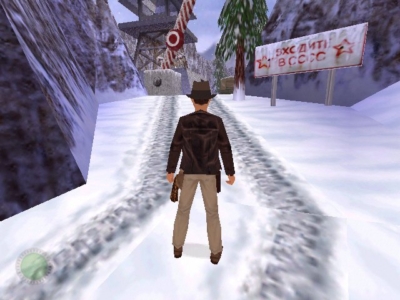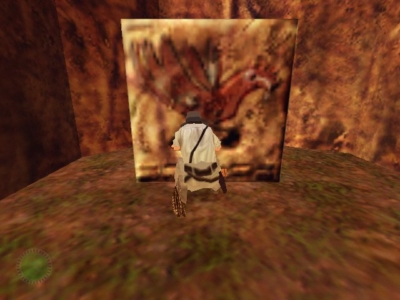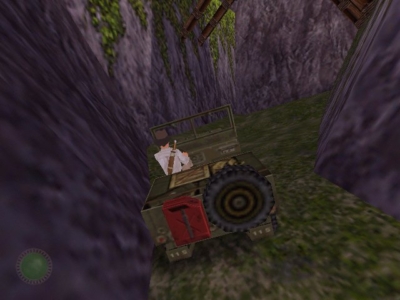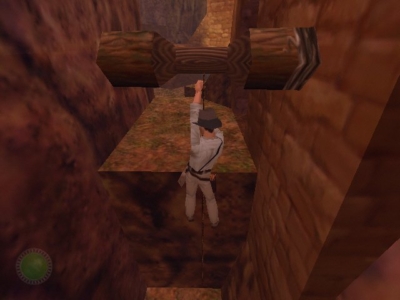
Indiana Jones and the Infernal Machine
Written by: Rik
Date posted: July 1, 2002
- Genre: Action
- Developed by: LucasArts
- Published by: LucasArts
- Year released: 1999
- Our score: 8
Be it on the cinema screen or the PC monitor, Indiana Jones has rarely put a foot wrong. Which is probably why he looks set to make a return to both, with (admittedly quite worrying) plans for Harrison Ford to return for a fourth film now confirmed, and shots of a new game available in a games magazine near you (since this was written, Indy’s new adventure Emperor’s Tomb has been released to mixed reviews – Stoo). In the meantime, though, if you’re a fan of the whip-cracking one, you should definitely give this recent effort from LucasArts a spin.
But wait a minute. A new Indiana Jones game, the first for several years, with an all-new plot and fabbo-whizzo graphics, which received a favourable set of reviews; in such circumstances, it seems almost inexplicable that any fans should have missed out on it first time around. Apart from the fact that it looks a bit like Tomb Raider. And since, for whatever reason, Tomb Raider has gradually acquired the title of All That Is Evil In The Gaming World among gaming snobs, most turned their noses up at The Infernal Machine.

Say what you like about the Nazis, but at least they didn’t have any bases in Siberia. Nevertheless, Indy stoically opts for the traditional shirt and leather jacket combo.
Now here’s the thing: a decent film relies on so many different ingredients – plot, dialogue, action, problem-solving – that to turn it into a game without losing any of those elements is a tricky process. The release of Indiana Jones and the Last Crusade highlighted the dilemma facing games developers with licenses. Lucasarts actually released two games: a point and click adventure (which was well-received) and a platform game (which wasn’t). The former lacked the involving action sequences of the film trilogy but, along with follow up Indiana Jones and the Fate of Atlantis, firmly established Indy’s gaming roots in the adventure camp. So when LucasArts announced in the late 1990s that Indy would be returning to star in a 3D action-adventure, a few people were mightily disappointed. They saw it as a cynical attempt to move with the gaming times: point and clickers were dying, if not already dead, and sales of Tomb Raider games had proved the popularity (and commercial value) of the third-person action game.
But this is a good game. And that’s coming from someone who has failed to play through more than a couple of levels of Tomb Raider in his life. Yes, at first glance it looks like LucasArts has just swapped Indy for Lara and sat back to count their cash, but then at first glance lots of first-person shooters look the same. It’s all about how the game plays, kids, and this plays well – all the way through to the end.

Okay, so you might have to do a little bit of box-pushing, but such tedious tasks aren’t really the main staple of the game.
Taking control of a post-WWII Indy, you are plucked from an archaeological dig to pursue the aforementioned Infernal Machine, which has rather inconveniently been broken into different pieces to be found in various locations around the world. In typical Indy fashion, it’s a mysterious artefact with a great deal of unexplained power, which could be dangerous if it fell into the wrong hands. In this case, those hands belong to the Soviet Union, conveniently taking the place of the Nazis as the token evil dictatorship. As Indy, you not only have to contend with an array of supernatural forces and natural obstacles, but also the might of the communist army as well.
It’s remarkably well done. At first, it all seems fairly standard fare: you shoot a few commies, you jump a ravine, you move a block from one place to another in order to climb up somewhere – you get the picture. However, what makes The Infernal Machine such a worthy and entertaining experience is the sheer variety of the levels. And while some of the levels are a little dull, others are completely gripping. There’s a great level early on involving the infiltration of a Soviet base; aside from providing for some great action set-pieces, when the carnage dies down you escape down a waterfall in a raft. In later levels, the developers pay homage to classic moments from the films: we get the mine-cart chases from Temple of Doom, the trapped-on-an-enemy-ship scenario from Raiders of the Lost Ark, and when things begin to get weird at the end of the game you’re reminded of The Last Crusade.

I don’t remember Indy driving a jeep in the films. Thankfully, there are also rafting and mining car levels, ‘for the fans’.
While fans of the previous games may be disappointed by the new action/adventure approach, the fact remains that puzzle solving is still the order of the day. The combat element represents only a minor element of the game, and if you find it too difficult you can turn the difficulty level right down and concentrate solely on getting through the level itself. True, most of those puzzles involve jumping, climbing and pulling levers, which won’t be enough to please die-hard point-and-click fans, but the inventory isn’t completely redundant. In addition, there are a couple of nice touches, like the opportunity to use your whip to swing across ravines and the fact that each piece of the Infernal Machine has a power of its own, which come in especially handy in the battles with the game’s larger foes.
Any faults? Well, the plot is a little bit underdeveloped; there’s a reasonable number of in-game cut scenes that use the game engine, but for my money there could be more, especially in the middle of the game. Too often you spend hours toiling through a particularly tough level, only to be immediately faced with the next one, which can only have a demoralising effect. The ending is also a little too brief, although ample compensation is provided by the bonus level earned by completing the game, which sees you return to Peru and the scene of the opening sequence from Raiders of the Lost Ark, boulders and all. The game’s biggest failing, however, is the fact that some of the puzzles are little obscure, with it often unclear to the player what he or she is supposed to do next in order to progress. The game does have an optional hint system to point you in the right direction, although you’re penalised for using this, and it doesn’t give you any more than the location of the puzzle you should be solving. On a couple of occasions, I have to admit to seeking advice from internet walkthrough guides, although even with screenshots provided for reference purposes I still found one section of the game very difficult to complete.

Using the whip as a rope. Don’t worry, though; there are also bits where you have to swing across ravines and stuff.
Still, Indiana Jones and the Infernal Machine is a triumph. If you’re a fan of the films, you really should give it a go if you haven’t already, and, yes, that’s even if you despise the thought of playing Tomb Raider. The action/adventure tag often implies a watered down playing experience, but in this case, it means a sublime mix of combat and problem-solving that successfully encapsulates the mood of a legendary film trilogy. Which is nice.


 Posts
Posts
I really loved the levels with the Jeep, because you could do a lot of cool stunts with it. Like jumping into chasms, clipping errors that put Russian soldiers right inside the enginge or parking on walls and ceilings. 😀
May 17, 2014 @ 8:35 pm
Haven’t played this game for a long time, but from what I remember the jeep bits were fairly workmanlike in their implementation. No special effort to make them particularly good, but nothing that stuck in the memory as particularly annoying or broken – otherwise I’m sure I would have mentioned it here!
May 23, 2014 @ 2:41 pm
Oh it isn’t broken in a bad way: As long as you do what you are supposed to do, the jeep works like a charm. But trying to step out of the jeep while driving up a wall or very slowly driving into/over Russian soldiers (in order to avoid ramming them) can lead to some very entertaining bugs. And I just like the dry humor of Indy saying “It’s not safe to leave the vehicle here” (or something like that) when trying to exit the jeep while it is dropping down an endless pit. 😀
May 23, 2014 @ 8:10 pm